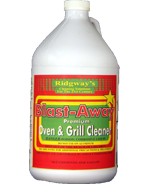Section 1
PRODUCT IDENTIFICATION
| PRODUCT NAME OR NUMBER | Blast Away Oven and Grill Cleaner |
| PRODUCT DESCRIPTION | Highly Alkaline Oven and Grill Cleaner |
| CHEMICAL FAMILY | N/A |
| D.O.T. PROPER SHIPPING NAME | Corrosive Liquid, N.O.S. (Contains Sodium Hydroxide) |
| SHIPPING ID NUMBER | UN1760 |
| HAZARD CLASS | 8 (Corrosive Material) Package group II |
| HMIS RATING | Health-3, Flammability-0. Reactivity-1 See section 8 for protective clothing. |
Section 2
HAZARDOUS INGREDIENTS / HAZARD DATA
| CHEMICAL NAME(S) | Sodium Hydroxide |
| CAS NUMBER | 1310-73-2 |
| TLV-TUA | 2 mg/m3 |
| PEL | 2 mg/m3 |
| This product contains no other ingredient considered hazardous according to the criteria of 29 CFR 1910.1200, OSHA | |
Section 3
PHYSICAL DATA
| BOILING/MELTING POINT @760 nm Hg | N.A. |
| pH | Greater than 14.0 |
| VAPOR PRESSURE mm Hg @ 20.5 C | N.A. |
| VAPOR DENSITY (Air = 1) | N.A. |
| PERCENT VOLATILE BY WEIGHT (%) | N.A. |
| SPECIFIC GRAVITY OR BULK DENSITY | 1.260 |
| SOLUBILITY IN WATER | Complete |
| EVAPORATION RATE (BuAc = 1) | N.A. |
| APPEARANCE | Thin clear amber colored liquid |
| ODOR | None Added |
Section 4
FIRE AND EXPLOSION HAZARD DATA
| FLASH POINT 0.5 F (Test Method) | N.A. |
| AUTOIGNITION TEMPERATURE | Non Flammable |
| FLAMMABILITY LIMITS IN AIR (% V) | N.A. |
| EXTINGUISING MEDIA | This product is not combustible. Water spray, foaa, carbon dioxide or dry chemical may be used where this product is stored. |
| SPECIAL FIRE FIGHTING PROCEDURES | Wear full protective clothing. Avoid direct contact of this predict with water as this can cause a violent exothermic reaction. |
| UNUSUAL FIRE & EXPLOSION HAZARDS | None |
Section 5
HEALTH HAZARD DATA
EFFECTS OF OVEREXPOSURE
| SKIN CONTACT | Corrosive. Contact may cause severe irritation, dermatitis, and chemical burns. |
| EYE CONTACT | Corrosive. Causes eye burns. May cause temporary or permanent vision loss and blindness. |
| INHALATION | Corrosive. Inhalation of dust or mist may cause irritation to nose, throat, and mucous membranes, pulmonary irritation, pulmonary edema, tissue damage and chemical burns. |
| INGESTION | Corrosive. Harmful or fatal if swallowed. May cause nausea, vomiting, and severe tissue damage to digestive tract- corrosive to mouth, throat, stomach and to other tissues- |
| CHRONIC EFFECTS OF OVEREXPOSURE | None |
| TOXICOLOGICAL TEST DATA | Caustic Soda, the key ingriedient in this product is a corrosive material. Acute Dermal LD50 (rabbit) 1,350 mg/kg |
Section 6
EMERGENCY AND FIRST AID PROCEDURES
| SKIN | Immediately wash with plenty of water for at least 15 minutes. Remove contaminated clothing and footwear. Wash clothing before reuse and discard footwear which cannot be decontaminated. Seek Medical attention immediately. |
| EYES | Immediately flush eyes with Large amounts of water for at Least 15 minutes forcibly holding lids apart to ensure flushing of entire surface, then seek medical attention immediately. |
| INGESTION | Never give anything by mouth to an unconscious person. If swallowed, do not induce vomiting. Give large quantities of water.Then seek medical attention immediately. |
| INHALATION | Remove to fresh air. If breathing is difficult have trained person administer oxygen. If respiration stops, give mouth to mouth resuscitation. Get medical attention. |
Section 7
REACTIVITY DATA
| PRODUCT STABILITY | stable |
| Stability Conditions to Avoid | Avoid mixing with any other cleraning product. Mix only with water. Do not store at high temperatures. Recommended storage temperature <100 F |
| CHEMICAL INCOMPATIBILITY | phosphoric acid, Muratic Acid, and other acidic materials, reducing agents, hydrocarbons, alcohols, ether, ammonia, ammoniated compounds and aluminum |
| HAZARDOUS DECOMPOSITION PRODUCTS | Mixing with incompatible materials may produce hydrogen, carbon monoxide, carbon dioxide, and other toxic and irritating fumes. |
| HAZARDOUS POLYMERIZATION | will not occur |
| Polymerization Conditions to Avoid | N.A. |
Section 8
SPECIAL PROTECTION INFORMATION
| RESPIRATORY PROTECTION | None required with normal use. |
| VENTILATION | Maintain adequate ventilation. Local exhaust not ordinarily needed. Avoid inhalation of mists containing this product. |
| PROTECTIVE CLOTHING | Wear full-cover protective clothing to prevent repeated or prolonged contact. |
| EYE PROTECTION | Safety glasses, safety goggles, and an eye-wash station |
| OTHER PRECAUTIONS | N.A. |
Section 9
ENVIRONMENTAL DATA
| SPILL OR LEAK PROCEDURES | wear proper protective equipment including rubber boots. Stop leak if you can do so without risk. Dike or dam large spills. Ventilate area if needed. Soak up with sand |
| WASTE DISPOSAL METHOD | Comply with all federal, state, and local regulations. Consult state and local authorities for restrictions on disposal of chemical waste. |
| CONTAINER DISPOSAL | Rinse empty container thoroughly with water before discarding. Please recycle empty containers whenever possible. |
